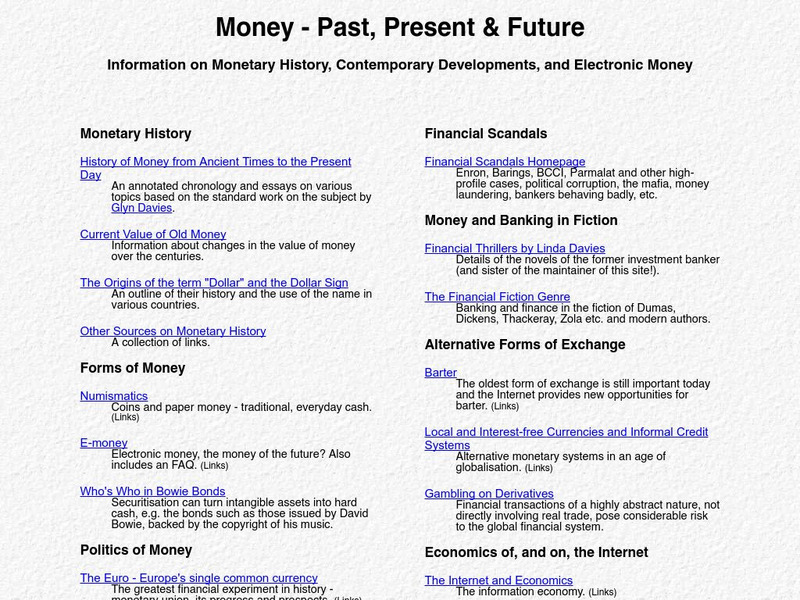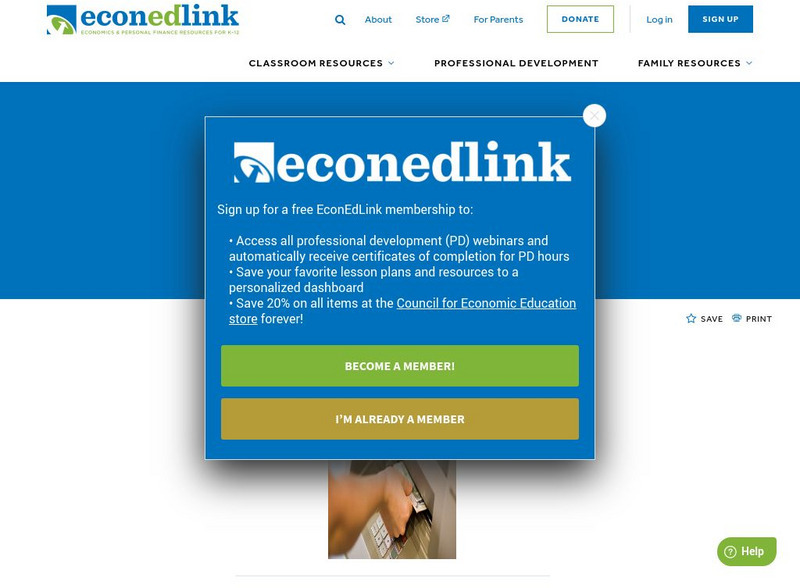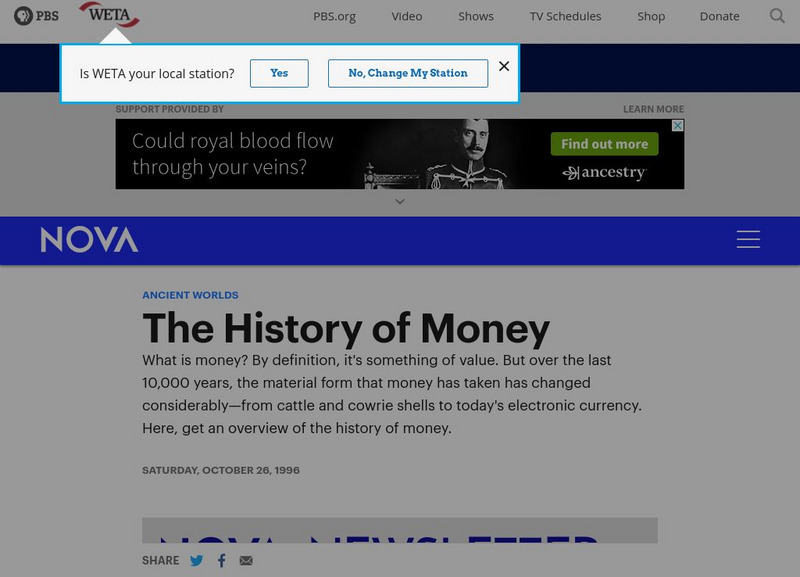PBS
Pbs: Count on It!: Episode 205 Blossom and Snappy Go to the Bank, Part I
Blossom and Snappy learn about money and banking. The puppets want to buy something for Robbie for her birthday, so they decide to do some chores to earn money. Once they've earned some money, they go to the bank to open up bank accounts.
Other
Roy Davies: Money
Explore the past, present, and future of money. Learn about exchange rates, money forms, banking, and more.
PBS
Pbs: Count on It!: Episode 206 Blossom and Snappy Go to the Bank, Part Ii
Blossom and Snappy continue to try to earn money for a present for Robbie's birthday by having a bake sale. They go back to the bank and learn about checking accounts and loans.
Council for Economic Education
Econ Ed Link: The Story of Jack and the Bank Stalk
Fairy tales have always been used to give lessons about life. The story of Jack and the Bean Stalk is a good instructional activity about the importance of knowing about money and banks. The story of Jack asks the question, "What is money?"
Crayola
Crayola: Money in the Bank
Young bankers and storekeepers practice counting money and making change. They keep their money in this recycled-box bank.
Council for Economic Education
Econ Ed Link: You Can Bank on This! (Part 1)
This is the first of four lessons on banking for elementary students. This lesson provides the students with information on banking; it also allows them to try out some procedures for thinking about money and banking. There is a link to...
PBS
Pbs: Your Life, Your Money: Educators & Families: Picking a Bank
Learn how to select a bank through comparing and contrasting bank options.
Texas Education Agency
Texas Gateway: Ch. 13: Money and Banking: Measuring Money: Currency, M1, and M2
By the end of this section, you will be able to do the following: Contrast M1 money supply and M2 money supply and classify monies as M1 money supply or M2 money supply.
Federal Reserve Bank
Federal Reserve Bank of Minneapolis: Counterfeit Protection
The Federal Reserve Bank of Minneapolis presents a page that looks at ways the Bureau of Engraving and Printing protects against the production of counterfeit money.
Federal Reserve Bank
Federal Reserve Bank of Atlanta: Spotting Counterfeit Currency
This resource explains how to detect counterfeit money, what to do if you receive it, and the laws against it.
Federal Reserve Bank
Federal Reserve Bank of Philadelphia: What Is Money? [Pdf]
This lesson plan is designed to help children understand the problems which arise from the bartering system so they appreciate the role money has in society.
Other
Biz Kids: Break the Bank
In this interactive game, you are a worker at a community bank, helping customers get good loans and save for their future. However, the terrible Mr. Boar and his clerks from a payday loan company have infiltrated your bank! Rally the...
PBS
Nova Online: History of Money
A timeline of money from 9000 B.C. to the present day that explains the types of money being used at various times in history.
Council for Economic Education
Econ Ed Link: Multipliers and the Mystery of the Magic Money
Students learn about the purpose of the reserve requirement, how money is "created" in the economy through fractional reserves, and how the Federal Reserve uses the reserve requirement and loans to correct economic instability.
Council for Economic Education
Econ Ed Link: Banks & Credit Unions (Part I)
Students learn about banks and credit unions, identifying similarities and differences between the two types of financial institution. They also evaluate a local bank and credit union to determine which one would be better suited to...
Council for Economic Education
Econ Ed Link: Agent Pincher: P Is for Penny or Where Did Money Come From?
What if we woke up tomorrow and found that there were no more pennies? Or what if we found that money had disappeared altogether -- not only from our pockets but from banks, stores and all the other places where we would expect to find...
Federal Trade Commission
Federal Trade Commission: Consumer: Opening a Bank Account
Tips for keeping your money safe in a bank or credit union. Learn the difference between a checking and savings account and the fees that banks and credit unions can charge.
USA Today
Usa Today: Money
USA Today's Money section covers the very latest in domestic and world economic news. Coverage also includes in-depth articles and editorials.
Texas Education Agency
Texas Gateway: Ch. 13: Money and Banking: Key Concepts and Summary
This section summarizes the key concepts presented in Ch. 13: Money and Banking from the Texas Gateway AP Macroeconomics online text.
Texas Education Agency
Texas Gateway: Ch. 13: Money and Banking: Key Terms
This is a list of key terms and definitions covered in Ch. 13: Money and Banking from the Texas Gateway AP Macroeconomics online text.
Texas Education Agency
Texas Gateway: Ch. 13: Money and Banking: Self Check Questions
This section provides self-check study questions to aid in understanding the content of Ch. 13: Money and Banking from the Texas Gateway AP Macroeconomics online text.
Texas Education Agency
Texas Gateway: Ch. 13: Money and Banking: Problems
This section features three problems to solve pertaining to the content of Ch. 13: Money and Banking from the Texas Gateway AP Macroeconomics online text.
Texas Education Agency
Texas Gateway: Ch. 13: Money and Banking: Review Questions
This section provides review questions to aid in studying the content of Ch. 13: Money and Banking from the Texas Gateway AP Macroeconomics online text.
ABCya
Ab Cya: Break the Bank Sorting
Break the Bank and learn how to sort money! In this game, kids get to break open fun piggy banks to reveal coins and dollars. Sort and organize the money correctly in order to get to a fun bonus game!





![Federal Reserve Bank of Philadelphia: What Is Money? [Pdf] Lesson Plan Federal Reserve Bank of Philadelphia: What Is Money? [Pdf] Lesson Plan](http://content.lessonplanet.com/resources/thumbnails/409977/large/bwluav9tywdpy2symdiwmduymc0xmdq5ny16ejvsywouanbn.jpg?1589982800)







